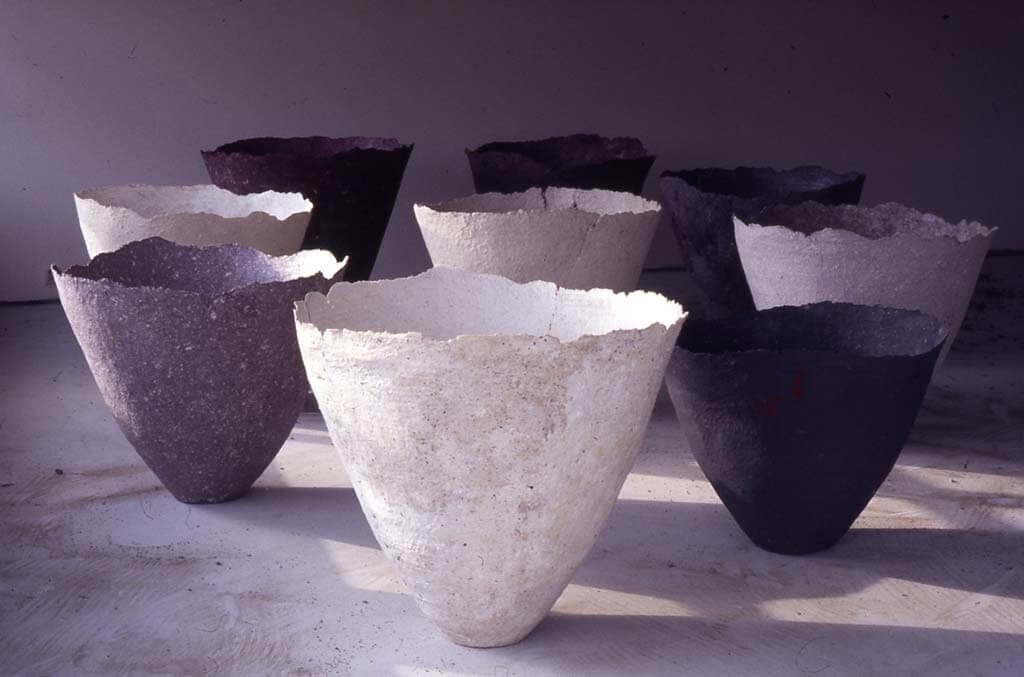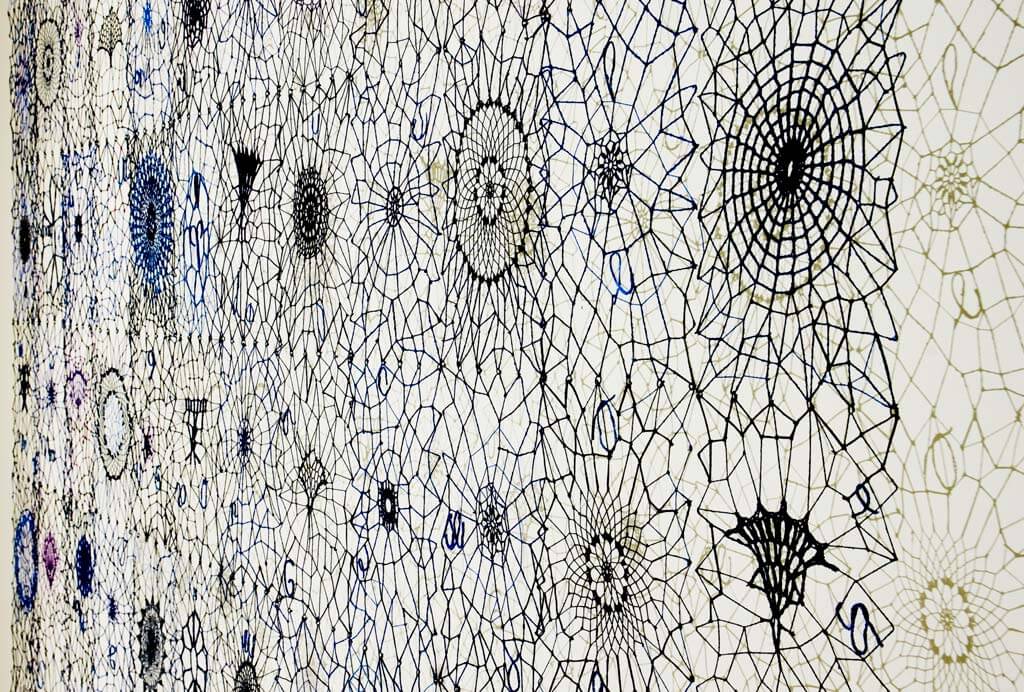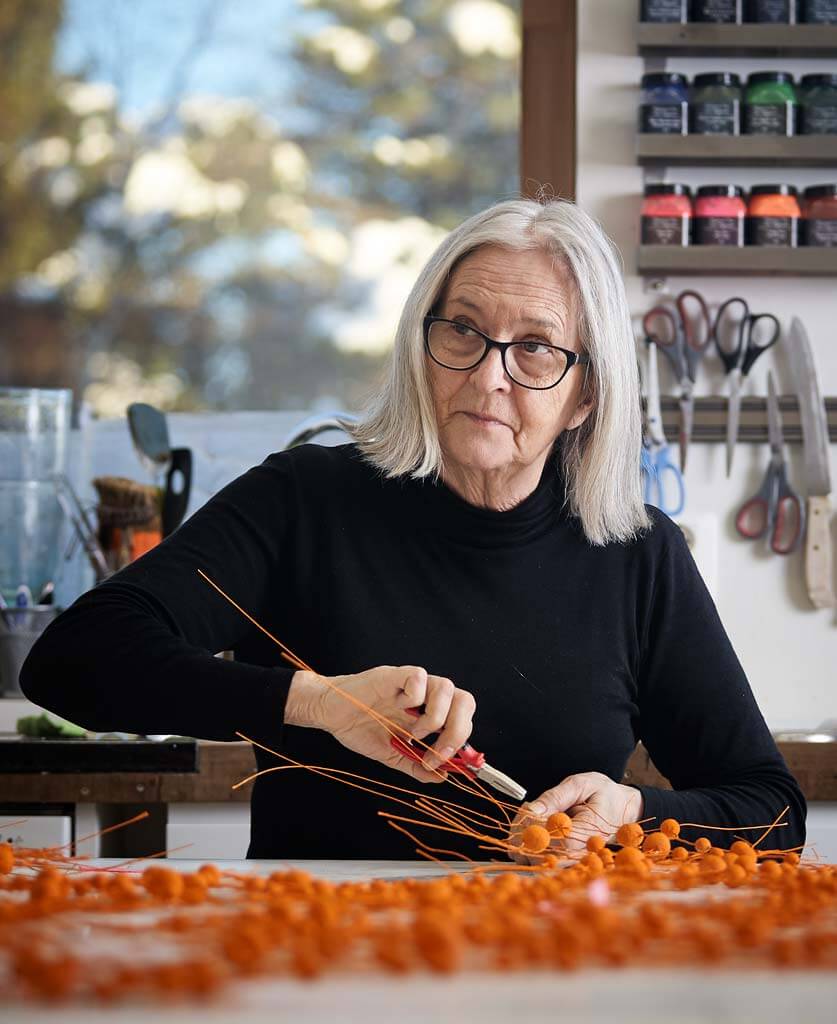THE NET
by Gjertrud Hals
Click on the image to open the gallery
I was born in 1948, on Finnøy, an island with two hundred inhabitants. My family was living close to the factory where my father and grandfather were mechanics, making and installing engines for the fishing boats. During my childhood, there was an abundance of herring fishing going on every winter. The herring were caught in large nets and hauled up in smaller ones. When the weather was bad, the harbor was packed with boats, and big bunches of fishnets were hanging to be dried. Every summer holiday I spent with my grandparents, living on the tiny island Notholmen (not=net) on Hustadvika. It is known as a dangerous part of the Norwegian coastline; many ships have been wrecked along it. In the evening, when the weather was good, I used to go with my grandfather, putting out the fishing nets. The next morning, I would always wake up early, eager to see the night’s catch. We used a rowing boat, and it was my job to maneuver the boat while my grandfather was hauling up the nets. Coming home, we worked on loosening the fish and crabs, and rinsing and hanging up the nets to dry.
“The net” has thus been a central theme in my life and art from the very beginning. I am frequently using childhood memories, as in Coral Sea from 2016: “When we were fishing with nets, sometimes big corals, we called them ‘sea trees,’ would be attached to them. When they came up from the water, they had bright yellow and red colors, that after a while would fade away. In my fantasy, they were greetings from a mysterious world deep down there, colorful and fantastic, unlike the world we were living in.”
In my family and community, many men, and a few women, were working on ships sailing to America and the Far East. They were bringing home items from an exotic world; my uncle gave us a lamp of translucent shells that I never could get enough of. I also was a passionate collector of shells and fancied the ones that were so thin that they let the light through. Today I can see a link between my fascination for shells and the Lava vases from the ’80s, made of cotton and flax fibers. Like the shell, they represent the protective membrane between life and death. A generation later, the transparencies were taken to a new level in the Ultima vessels (2013). It seems like a way to express our vulnerable lives and civilization. We are building roads, houses, cities, while underneath, the untamed forces of nature are roaring. On the other hand, to quote myself (1987): “A cleavage of the membrane at the right moment may signify life liberating itself, or an idea or thought breaking forth and materializing itself in creativity.”
Since the few rare and exotic items we had in our modest post-war homes often were bought in places like Yokohama and Kobe, Japan early became the “far-away country” I was dreaming of.
Later, in the 1970s, I became interested in Zen Buddhism. Simplicity, meditation, and paradox were aspects of Zen aesthetics that appealed to me. So when I eventually came to Japan, in 1989, I thought I was well informed. However, I was not prepared for Shintoism, Japan’s old nature-worshipping religion, which made a huge impact on me. Coming home, after six weeks, I felt a strong urge to find something in my own culture that could cope with this experience. It led me to Voluspa (The Song of the Sybil), one of the most important epic poems of Norse mythology: the sun turns black and falls into the sea before the world is destroyed, and a new world is born. Since then, I have made many artworks with inspiration from Voluspa, like Black Sun,1995, and Fenris, 2004. Fenris refers to the Fenris Wolf who was chained by Gleipnir, a chain as soft as silk, with many intricate components. If it broke, the wolf would get loose and cause Ragnarok (doomsday).
Mythology is for me a never-ending source of inspiration, and relating to history and mythology is a way to deal with what is happening in today’s world. Like life itself, the mythological symbols are complex, profound, and interesting, not immediately easy to catch or understand. However, more than anything else, I am inspired by my own memories and experiences, and at my age, I have plenty to choose from. Some of my artwork takes a long time to find its shape, as was the case with Midnight Blue, 2018.
The title Midnight Blue refers to the color midnight blue, the darkest shade of indigo.
Click to open
When I was a student, in my twenties, I learned weaving and dying techniques. I became especially interested in the rather complicated but fascinating way of indigo dying. As long as the material is in the dye bath, it has no color, but lifted up from the bath, it quickly combines with oxygen and becomes intense blue. So, after many years, I found a bunch of indigo-colored linen and cotton thread from my student days, and I got the idea to make a midnight blue artwork out of it. That means it took like forty-five years from when the material was dyed until it ended up in an artwork. The techniques I have used are crocheting, knitting, lacework, and macrame. Some elements are found objects, others I made from scratch, all bound together in a network. One of the most significant works for me is the net sculpture Insula, that was made 2006–2008. I was living in Oslo at the time, and for a long period, I had no studio, so I was working from our apartment.
Click to zoom in
My husband, Odd, is a psychologist, and since we met in 1970, he also, amongst other, has been my sparring partner. At this stage, he was much into neuropsychology, and his books were all over the place. Looking at them, I wanted to make an image of the human nervous system, abstracted into a square. In this process, he came up with the term insula: insula is the Latin word for island, and it also refers to insular cortex, a central structure inside the brain. It is believed to be involved with consciousness and plays a role in diverse functions usually linked to emotions and perception of ourselves as isolated creatures, and to our consciousness of the self. At the same time, insula is also referring to “the island” and has a resemblance to coral reefs, another of my favorite themes. I made it with metal wire into nine 100 X 100 cm squares. I then rented a place where I sprayed the grid structures with dyed, liquified paper pulp, about fifty layers. For me, it was a groundbreaking method, that I since have used several times, as in Tela and Vena Cuprum, both in 2018, and recently in Tela Organic 2021.
My last project, G&O, was also realized in cooperation with my husband. Due to COVID-19, we could not celebrate our fiftieth wedding anniversary in January, together with our family. So instead, we started making an installation together: from reused material, Odd made a light structure of shelves. It goes from the floor to the ceiling in my five-meter-high studio, and I filled it up with baskets and other items that had been piled up in a corner. It felt like a good way to celebrate of long life together!
-
Gjertrud Hals was born and raised on a small island on the northwestern coast of Norway, which has, to a large extent, influenced her artwork. As a seasoned traveler, she has observed many different cultures. Much of her artistic work is an attempt to express the connection between the island’s micro-history and the world’s macro-history. She was educated as a tapestry weaver; however, she soon started experimenting with other techniques. Her breakthrough came in the late 1980s with Lava, a series of one-meter-high urns made of cotton and flax pulp. These vessels marked her transition from textile to fiber art. She makes objects that vary in nature and in the techniques applied: casting, spraying, cutting, knitting, and weaving. She enjoys creatively acting as she pleases, using whatever material she wishes, being severe and meditative one day and playful the next.
-
Instagram: https://www.instagram.com/gjertrudhals/
-
Facebook: https://www.facebook.com/gjertrud.hals/
-
Website: https://www.gjertrud-hals.com/
-
Contact Email: gjertrudhals@gmail.com
ROOM is entirely dependent upon reader support. Please consider helping ROOM today with a tax-deductible donation. Any amount is deeply appreciated. |







![Genesis, 2024 [Detail]](https://analytic-room.com/wp-content/uploads/2025/07/HQ27-TL20896S_Tau_Lewis__title_TBC__small_figure___2024_6_high_quality-110x80.jpg)

